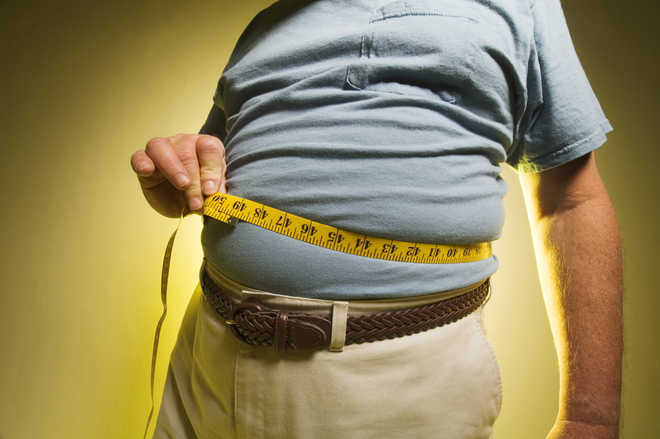Washington, June 12
Injecting fat pockets with carbon dioxide gas may help reduce belly fat, scientists have found.
“Carboxytherapy could potentially be a new and effective means of fat reduction. It still needs to be optimised, though, so it’s long lasting,” said Murad Alam, from Northwestern University in the US.
The new technique’s benefits are that it is a “safe, inexpensive gas, and injecting it into fat pockets may be preferred by patients who like natural treatments,” said Alam, lead author of the study published in the Journal of the American Academy of Dermatology.
“Non-invasive fat reduction has become increasingly sought-after by patients,” said Alam.
Benefits of a non-invasive approach are diminished downtime, avoidance of scarring and perceived safety.
Current technologies routinely used for non-invasive fat reduction include cryolipolysis, high intensity ultrasound, radiofrequency, chemical adipocytolysis and laser-assisted fat reduction.
Carboxytherapy has been performed primarily outside the US, with a few clinical studies suggesting it may provide a lasting improvement in abdominal contours.
The way carboxytherapy works is not well understood. It is believed that injection of carbon dioxide causes changes in the microcirculation, and damages fat cells.
No randomised controlled trials for carboxytherapy efficacy and benefit over time have been previously conducted.
The purpose of this study was to assess the effectiveness of carboxytherapy for fat reduction in a randomised, controlled trial, and to determine if any observed benefits persisted for six months.
The study consisted of 16 adults who were not overweight and were randomised to get weekly carbon dioxide gas injection to one side of their abdomens and a sham treatment on the other side once a week for five weeks.
A high-resolution ultrasound detected a reduction in superficial fat after five weeks but not at 28 weeks. The patients’ body weight did not change over the course of the study.
That the difference was not maintained at six months suggests the treatment stimulated a temporary metabolic process that reduced the size of fat cells without inducing cell death, Alam said.
“If carboxytherapy can provide prolonged benefits, it offers patients yet another non-invasive option for fat reduction. But we don’t feel it’s ready for prime time,” Alam said.
Breaking News
 Driving Naari Programme launched in Chandigarh
Driving Naari Programme launched in Chandigarh Punjab farmers reaping benefits of Mann Government’s crop diversification initiatives
Punjab farmers reaping benefits of Mann Government’s crop diversification initiatives Punjab and Kerala Join Hands to Address NRI Concerns
Punjab and Kerala Join Hands to Address NRI Concerns Macron refuses French Prime Minister’s resignation after chaotic election results
Macron refuses French Prime Minister’s resignation after chaotic election results Modi lands in Russia for first visit since Ukraine offensive
Modi lands in Russia for first visit since Ukraine offensive Saudi Arabia approves granting citizenship to global experts under Vision 2030
Saudi Arabia approves granting citizenship to global experts under Vision 2030 Vigilance arrests Panchayat Secretary, former Sarpanch for embezzlement in Panchayat funds
Vigilance arrests Panchayat Secretary, former Sarpanch for embezzlement in Panchayat funds Housing crisis in Canada forcing residents to move out of pricier cities: Poll
Housing crisis in Canada forcing residents to move out of pricier cities: Poll Historic Milestone: Canada Appoints Its First Female Chief of Defense
Historic Milestone: Canada Appoints Its First Female Chief of Defense Victory parade of T20 World Cup-winning Indian cricket team concludes in Mumbai
Victory parade of T20 World Cup-winning Indian cricket team concludes in Mumbai Maximizing impact of Aadhar in Punjab
Maximizing impact of Aadhar in Punjab Amritpal Singh to take oath as Khadoor Sahib MP on July 5
Amritpal Singh to take oath as Khadoor Sahib MP on July 5
 Driving Naari Programme launched in Chandigarh
Driving Naari Programme launched in Chandigarh Punjab farmers reaping benefits of Mann Government’s crop diversification initiatives
Punjab farmers reaping benefits of Mann Government’s crop diversification initiatives Punjab and Kerala Join Hands to Address NRI Concerns
Punjab and Kerala Join Hands to Address NRI Concerns Macron refuses French Prime Minister’s resignation after chaotic election results
Macron refuses French Prime Minister’s resignation after chaotic election results Modi lands in Russia for first visit since Ukraine offensive
Modi lands in Russia for first visit since Ukraine offensive Saudi Arabia approves granting citizenship to global experts under Vision 2030
Saudi Arabia approves granting citizenship to global experts under Vision 2030 Vigilance arrests Panchayat Secretary, former Sarpanch for embezzlement in Panchayat funds
Vigilance arrests Panchayat Secretary, former Sarpanch for embezzlement in Panchayat funds Housing crisis in Canada forcing residents to move out of pricier cities: Poll
Housing crisis in Canada forcing residents to move out of pricier cities: Poll Historic Milestone: Canada Appoints Its First Female Chief of Defense
Historic Milestone: Canada Appoints Its First Female Chief of Defense Victory parade of T20 World Cup-winning Indian cricket team concludes in Mumbai
Victory parade of T20 World Cup-winning Indian cricket team concludes in Mumbai Maximizing impact of Aadhar in Punjab
Maximizing impact of Aadhar in Punjab Amritpal Singh to take oath as Khadoor Sahib MP on July 5
Amritpal Singh to take oath as Khadoor Sahib MP on July 5




































